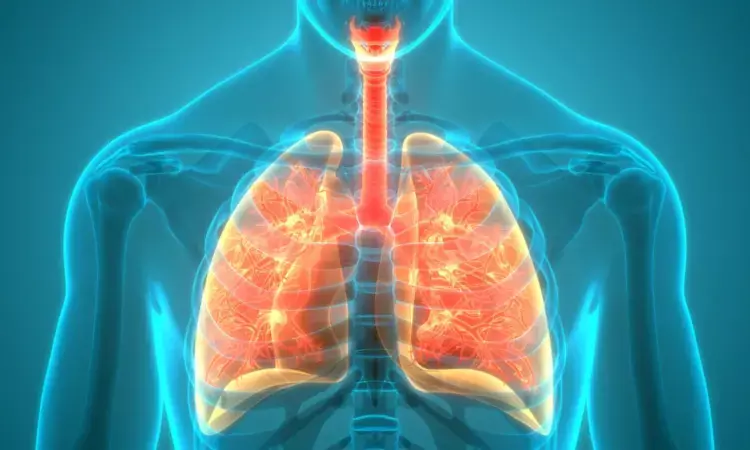- Home
- Medical news & Guidelines
- Anesthesiology
- Cardiology and CTVS
- Critical Care
- Dentistry
- Dermatology
- Diabetes and Endocrinology
- ENT
- Gastroenterology
- Medicine
- Nephrology
- Neurology
- Obstretics-Gynaecology
- Oncology
- Ophthalmology
- Orthopaedics
- Pediatrics-Neonatology
- Psychiatry
- Pulmonology
- Radiology
- Surgery
- Urology
- Laboratory Medicine
- Diet
- Nursing
- Paramedical
- Physiotherapy
- Health news
- Fact Check
- Bone Health Fact Check
- Brain Health Fact Check
- Cancer Related Fact Check
- Child Care Fact Check
- Dental and oral health fact check
- Diabetes and metabolic health fact check
- Diet and Nutrition Fact Check
- Eye and ENT Care Fact Check
- Fitness fact check
- Gut health fact check
- Heart health fact check
- Kidney health fact check
- Medical education fact check
- Men's health fact check
- Respiratory fact check
- Skin and hair care fact check
- Vaccine and Immunization fact check
- Women's health fact check
- AYUSH
- State News
- Andaman and Nicobar Islands
- Andhra Pradesh
- Arunachal Pradesh
- Assam
- Bihar
- Chandigarh
- Chattisgarh
- Dadra and Nagar Haveli
- Daman and Diu
- Delhi
- Goa
- Gujarat
- Haryana
- Himachal Pradesh
- Jammu & Kashmir
- Jharkhand
- Karnataka
- Kerala
- Ladakh
- Lakshadweep
- Madhya Pradesh
- Maharashtra
- Manipur
- Meghalaya
- Mizoram
- Nagaland
- Odisha
- Puducherry
- Punjab
- Rajasthan
- Sikkim
- Tamil Nadu
- Telangana
- Tripura
- Uttar Pradesh
- Uttrakhand
- West Bengal
- Medical Education
- Industry
Elexacaftor-tezacaftor-ivacaftor therapy provides relief from chronic rhinosinusitis in patients with cystic fibrosis: JAMA

USA: Treatment with elexacaftor-tezacaftor-ivacaftor (ETI; Trikafta) therapy is associated with improved chronic sinus disease and clinical outcomes in patients with cystic fibrosis (CF). The findings were published online in JAMA Otolaryngology–Head & Neck Surgery on September 7, 2023.
The cohort study of 64 individuals with cystic fibrosis revealed that after 1 year of ETI therapy, the researchers noted a reduction in the median total Lund-Mackay sinus CT scoring system and the Sheikh-Lind scoring system (from 5.8 to 3.3 and from 3.8 to 2.2, respectively). They also observed an improvement in the mean per cent predicted forced expiratory volume in 1 second and BMI (body mass index), and there was a reduction in bacterial colonization.
Cystic fibrosis is a multiorgan genetic disease with progressive lower and upper airway involvement. The effects of CF transmembrane conductance regulator (CFTR) modifier therapies on cystic fibrosis-related upper airway disease, particularly chronic rhinosinusitis (CRS), are not characterized. Therefore, Shahid Sheikh, The Ohio State University College of Medicine, Columbus, and colleagues aimed to determine the outcome of ETI therapy on CRS as measured by changes in sinus computed tomography (CT) metrics and clinical parameters in patients with CF.
For this purpose, the researchers conducted a prospective longitudinal cohort study at the CF centre of a tertiary care hospital between 2019 and 2021. The analysis included 64 participants with cystic fibrosis.
They obtained sinus CT within 1 month of ETI therapy's initiation (baseline) and 1 month of 1 year of ETI therapy. Independent analysis of images was done by radiology, pulmonology, and otolaryngology physicians, using the Lund-Mackay and Sheikh-Lind scoring systems. Percent predicted forced expiratory volume in 1 second (ppFEV1), BMI, and microbiologic data collected at ETI therapy initiation and 3-month intervals for 1 year were also measured.
The researchers hypothesized that ETI therapy will improve CRS as measured by changes in sinus CT at initiation and 1 year after ETI therapy and clinical parameters in CF patients.
The study led to the following findings:
- Among the 64 participants (60.9% female; median age, 18.5 years), improvement in CRS was noted by improvements in sinus CT scans using both sinus CT scoring systems after 1 year of ETI therapy.
- The reduction in the median total score using the Lund-Mackay sinus CT scoring system (from 5.8 to 3.3) and the Sheikh-Lind scoring system (from 3.8 to 2.2) was noted.
- Increases in ppFEV1 and BMI were also observed by 3 months of ETI therapy with persistent improvement through 1 year of treatment.
- After 1 year of ETI therapy, participants with CF had reductions in positivity for Pseudomonas aeruginosa and Staphylococcus aureus in oropharyngeal cultures.
"Findings showed that the use of ETI therapy was associated with improved CRS outcomes in CF patients as quantified by improved sinus CT scans measured by 2 radiographic scoring systems and was also associated with improved clinical outcomes," the researchers wrote. "Despite improvement in CT scan scores, most people with cystic fibrosis continue to have scores that indicate severe sinus disease."
"There is a need for randomized trials with appropriate control groups to assess the efficacy of this therapy on chronic sinus disease in this population," they concluded.
Reference:
Sheikh S, Ho M, Eisner M, et al. Elexacaftor-Tezacaftor-Ivacaftor Therapy for Chronic Sinus Disease in Cystic Fibrosis. JAMA Otolaryngol Head Neck Surg. Published online September 07, 2023. doi:10.1001/jamaoto.2023.2701
Dr Kamal Kant Kohli-MBBS, DTCD- a chest specialist with more than 30 years of practice and a flair for writing clinical articles, Dr Kamal Kant Kohli joined Medical Dialogues as a Chief Editor of Medical News. Besides writing articles, as an editor, he proofreads and verifies all the medical content published on Medical Dialogues including those coming from journals, studies,medical conferences,guidelines etc. Email: drkohli@medicaldialogues.in. Contact no. 011-43720751


